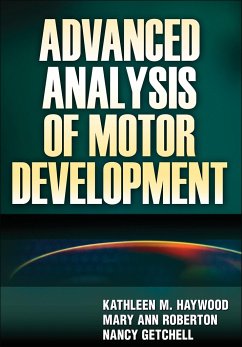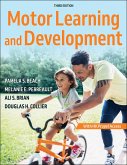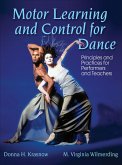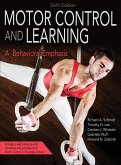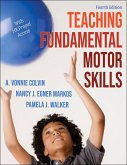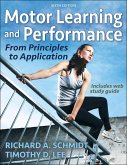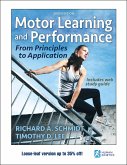- Gebundenes Buch
- Merkliste
- Auf die Merkliste
- Bewerten Bewerten
- Teilen
- Produkt teilen
- Produkterinnerung
- Produkterinnerung
Advanced Analysis of Motor Development teaches readers to critically analyze research methods and results as they deepen their understanding of developmental phenomena. The text introduces the main models and theories that have influenced the field and offers in-depth examination of key studies.
Andere Kunden interessierten sich auch für
![Motor Learning and Development Motor Learning and Development]() Pamela S. BeachMotor Learning and Development140,99 €
Pamela S. BeachMotor Learning and Development140,99 €![Motor Learning and Control for Dance Motor Learning and Control for Dance]() Donna KrasnowMotor Learning and Control for Dance69,99 €
Donna KrasnowMotor Learning and Control for Dance69,99 €![Motor Control and Learning Motor Control and Learning]() Richard A. SchmidtMotor Control and Learning132,99 €
Richard A. SchmidtMotor Control and Learning132,99 €![Racing Green Racing Green]() Kit ChapmanRacing Green11,99 €
Kit ChapmanRacing Green11,99 €![Teaching Fundamental Motor Skills Teaching Fundamental Motor Skills]() A. Vonnie ColvinTeaching Fundamental Motor Skills76,99 €
A. Vonnie ColvinTeaching Fundamental Motor Skills76,99 €![Motor Learning and Performance Motor Learning and Performance]() Richard A. SchmidtMotor Learning and Performance142,99 €
Richard A. SchmidtMotor Learning and Performance142,99 €![Motor Learning and Performance 6th Edition With Web Study Guide-Loose-Leaf Edition Motor Learning and Performance 6th Edition With Web Study Guide-Loose-Leaf Edition]() Richard A. SchmidtMotor Learning and Performance 6th Edition With Web Study Guide-Loose-Leaf Edition103,99 €
Richard A. SchmidtMotor Learning and Performance 6th Edition With Web Study Guide-Loose-Leaf Edition103,99 €-
-
-
Advanced Analysis of Motor Development teaches readers to critically analyze research methods and results as they deepen their understanding of developmental phenomena. The text introduces the main models and theories that have influenced the field and offers in-depth examination of key studies.
Hinweis: Dieser Artikel kann nur an eine deutsche Lieferadresse ausgeliefert werden.
Hinweis: Dieser Artikel kann nur an eine deutsche Lieferadresse ausgeliefert werden.
Produktdetails
- Produktdetails
- Verlag: Human Kinetics Publishers
- Seitenzahl: 320
- Erscheinungstermin: 30. Dezember 2011
- Englisch
- Abmessung: 267mm x 187mm x 35mm
- Gewicht: 852g
- ISBN-13: 9780736073936
- ISBN-10: 0736073930
- Artikelnr.: 34329901
- Herstellerkennzeichnung
- Libri GmbH
- Europaallee 1
- 36244 Bad Hersfeld
- gpsr@libri.de
- Verlag: Human Kinetics Publishers
- Seitenzahl: 320
- Erscheinungstermin: 30. Dezember 2011
- Englisch
- Abmessung: 267mm x 187mm x 35mm
- Gewicht: 852g
- ISBN-13: 9780736073936
- ISBN-10: 0736073930
- Artikelnr.: 34329901
- Herstellerkennzeichnung
- Libri GmbH
- Europaallee 1
- 36244 Bad Hersfeld
- gpsr@libri.de
Kathleen M. Haywood, PhD, is a professor and associate dean for graduate education at the University of Missouri-St. Louis, where she researches life span motor development and teaches courses in motor behavior and development, sport psychology, and biomechanics. She earned her PhD in motor behavior from the University of Illinois at Urbana-Champaign in 1976. Haywood is a fellow of the National Academy of Kinesiology and the Research Consortium of the American Alliance for Health, Physical Education, Recreation and Dance (AAHPERD). She has served as president of the North American Society for the Psychology of Sport and Physical Activity and as chairperson of the Motor Development Academy of AAHPERD. Haywood is also a recipient of AAHPERD's Mabel Lee Award. Haywood is also the coauthor of the first, second, and third editions of Archery: Steps to Success and Teaching Archery: Steps to Success and coauthor of Life Span Motor Development, also published by Human Kinetics. She resides in Saint Charles, Missouri. In her free time she enjoys fitness training, tennis, and dog training. Mary Ann Roberton, PhD, is professor emeritus and past director of the School of Human Movement, Sport, and Leisure Studies at Bowling Green State University in Bowling Green, Ohio. Roberton has been researching and writing about motor development for over 35 years and is well known for her study of developmental sequences in motor development and its application for physical education teachers and physical therapists. In addition to Advanced Analysis of Motor Development, Roberton has authored one scholarly book, several book chapters, numerous journal articles, and invited and refereed papers. In 2011 Roberton received the Hall of Fame Award from the National Association for Sport and Physical Education. She is a fellow of the Research Consortium of the American Alliance for Health, Physical Education, Recreation and Dance (AAHPERD) and was inducted as a fellow into the National Academy of Kinesiology in 2003. A distinguished faculty member, Roberton was awarded the Faculty Mentor Award in 2000 from Bowling Green State University. Honoring her service to the university and the profession, the Mary Ann Roberton Outstanding Thesis Award and Mary Ann Roberton Outstanding Project Award were established in 1999 by the faculty of the School of Human Movement, Sport, and Leisure Studies at Bowling Green State University. Roberton resides in Madison, Wisconsin. Retired since 2005, she remains active in research and scholarship. In her free time she enjoys swimming, cycling, and reading. Nancy Getchell, PhD, is an associate professor at the University of Delaware in Newark. She has taught courses in motor development, motor control and learning, research methods, and women in sport. For nearly 20 years, Getchell has focused her research on motor development. She is a fellow of the Research Consortium of the American Alliance for Health, Physical Education, Recreation and Dance (AAHPERD). She is a member of the North American Society for the Psychology of Sport and Physical Activity, the International Society of Motor Control, and AAHPERD. Getchell also served as the section editor for the Growth and Motor Development section of Research Quarterly for Exercise and Sport from 2005 to 2009 and chairperson of the AAHPERD Motor Development aand Learning Academy. In 2001, Getchell was the recipient of the Lolas E. Halverson Young Investigators Award in motor development. She earned a PhD in kinesiology from the University of Wisconsin at Madison in 1996. Getchell resides in Wilmington, Delaware, where she enjoys hiking, playing soccer, and bicycling.
Part I. What Is Motor Development? Theoretical Perspectives
Chapter 1. Descriptive Perspectives
Definition of Motor Development Study
History of Motor Development in the United States
Concept of Development
Three Early Pioneers of Motor Development
Stage Versus Age
Physical Educators and Kinesiologists in the Field
Legacies From the Descriptive Perspectives
Specific Contributions of the Descriptive Perspectives
Role of Description Within Motor Development Research
Chapter 2. Perspectives on Perception and Action
Indirect Perspective
Direct Perspective
A Resolution?
Summary
Chapter 3. Systems Perspective
Model of Constraints
Dynamic Systems
Applying the Dynamic Systems Model to a Motor Development Problem
Summary
Chapter 4. Motor Development Research Approaches
Research Designs
Development Simulation
Dependent Variables
Anthropometric Measures
Moving the Field Forward: Strong Inference Research
Moving the Field Forward: Wohlwill's Developmental Research Schema
Research Methods in Practice: Esther Thelen and Reflex Stepping
Part II. What Perspectives Do Researchers Use to Study Motor Development?
Contemporary Research
Chapter 5. Development of Postural Control
Theoretical Perspectives
Early Development
Rising to Stand
Postural Control in Older Adulthood
Summary
Chapter 6. Development of Foot Locomotion
Intertask Developmental Sequence
Intratask Developmental Sequences
Further Study
Chapter 7. Development of Ballistic Skills
Intertask Developmental Sequence
Intratask Developmental Sequences
Developmental Research
Chapter 8. Development of Manipulative Skills
Reaching and Grasping
Interception Skills
Summary
Part III. How Do Practitioners Adopt a Developmental Perspective? Applying
Research
Chapter 9. Atypical Motor Development
Identifying Atypical Development by Understanding Typical Development
Motor Development That Is Not Average
Combining Theory and Practice
Summary
Chapter 10. Advances in Interventions
Interventions in Typically Developing Populations
Interventions for Atypical Populations
Interventions for Children With Disabilities
Summary
Chapter 1. Descriptive Perspectives
Definition of Motor Development Study
History of Motor Development in the United States
Concept of Development
Three Early Pioneers of Motor Development
Stage Versus Age
Physical Educators and Kinesiologists in the Field
Legacies From the Descriptive Perspectives
Specific Contributions of the Descriptive Perspectives
Role of Description Within Motor Development Research
Chapter 2. Perspectives on Perception and Action
Indirect Perspective
Direct Perspective
A Resolution?
Summary
Chapter 3. Systems Perspective
Model of Constraints
Dynamic Systems
Applying the Dynamic Systems Model to a Motor Development Problem
Summary
Chapter 4. Motor Development Research Approaches
Research Designs
Development Simulation
Dependent Variables
Anthropometric Measures
Moving the Field Forward: Strong Inference Research
Moving the Field Forward: Wohlwill's Developmental Research Schema
Research Methods in Practice: Esther Thelen and Reflex Stepping
Part II. What Perspectives Do Researchers Use to Study Motor Development?
Contemporary Research
Chapter 5. Development of Postural Control
Theoretical Perspectives
Early Development
Rising to Stand
Postural Control in Older Adulthood
Summary
Chapter 6. Development of Foot Locomotion
Intertask Developmental Sequence
Intratask Developmental Sequences
Further Study
Chapter 7. Development of Ballistic Skills
Intertask Developmental Sequence
Intratask Developmental Sequences
Developmental Research
Chapter 8. Development of Manipulative Skills
Reaching and Grasping
Interception Skills
Summary
Part III. How Do Practitioners Adopt a Developmental Perspective? Applying
Research
Chapter 9. Atypical Motor Development
Identifying Atypical Development by Understanding Typical Development
Motor Development That Is Not Average
Combining Theory and Practice
Summary
Chapter 10. Advances in Interventions
Interventions in Typically Developing Populations
Interventions for Atypical Populations
Interventions for Children With Disabilities
Summary
Part I. What Is Motor Development? Theoretical Perspectives
Chapter 1. Descriptive Perspectives
Definition of Motor Development Study
History of Motor Development in the United States
Concept of Development
Three Early Pioneers of Motor Development
Stage Versus Age
Physical Educators and Kinesiologists in the Field
Legacies From the Descriptive Perspectives
Specific Contributions of the Descriptive Perspectives
Role of Description Within Motor Development Research
Chapter 2. Perspectives on Perception and Action
Indirect Perspective
Direct Perspective
A Resolution?
Summary
Chapter 3. Systems Perspective
Model of Constraints
Dynamic Systems
Applying the Dynamic Systems Model to a Motor Development Problem
Summary
Chapter 4. Motor Development Research Approaches
Research Designs
Development Simulation
Dependent Variables
Anthropometric Measures
Moving the Field Forward: Strong Inference Research
Moving the Field Forward: Wohlwill's Developmental Research Schema
Research Methods in Practice: Esther Thelen and Reflex Stepping
Part II. What Perspectives Do Researchers Use to Study Motor Development?
Contemporary Research
Chapter 5. Development of Postural Control
Theoretical Perspectives
Early Development
Rising to Stand
Postural Control in Older Adulthood
Summary
Chapter 6. Development of Foot Locomotion
Intertask Developmental Sequence
Intratask Developmental Sequences
Further Study
Chapter 7. Development of Ballistic Skills
Intertask Developmental Sequence
Intratask Developmental Sequences
Developmental Research
Chapter 8. Development of Manipulative Skills
Reaching and Grasping
Interception Skills
Summary
Part III. How Do Practitioners Adopt a Developmental Perspective? Applying
Research
Chapter 9. Atypical Motor Development
Identifying Atypical Development by Understanding Typical Development
Motor Development That Is Not Average
Combining Theory and Practice
Summary
Chapter 10. Advances in Interventions
Interventions in Typically Developing Populations
Interventions for Atypical Populations
Interventions for Children With Disabilities
Summary
Chapter 1. Descriptive Perspectives
Definition of Motor Development Study
History of Motor Development in the United States
Concept of Development
Three Early Pioneers of Motor Development
Stage Versus Age
Physical Educators and Kinesiologists in the Field
Legacies From the Descriptive Perspectives
Specific Contributions of the Descriptive Perspectives
Role of Description Within Motor Development Research
Chapter 2. Perspectives on Perception and Action
Indirect Perspective
Direct Perspective
A Resolution?
Summary
Chapter 3. Systems Perspective
Model of Constraints
Dynamic Systems
Applying the Dynamic Systems Model to a Motor Development Problem
Summary
Chapter 4. Motor Development Research Approaches
Research Designs
Development Simulation
Dependent Variables
Anthropometric Measures
Moving the Field Forward: Strong Inference Research
Moving the Field Forward: Wohlwill's Developmental Research Schema
Research Methods in Practice: Esther Thelen and Reflex Stepping
Part II. What Perspectives Do Researchers Use to Study Motor Development?
Contemporary Research
Chapter 5. Development of Postural Control
Theoretical Perspectives
Early Development
Rising to Stand
Postural Control in Older Adulthood
Summary
Chapter 6. Development of Foot Locomotion
Intertask Developmental Sequence
Intratask Developmental Sequences
Further Study
Chapter 7. Development of Ballistic Skills
Intertask Developmental Sequence
Intratask Developmental Sequences
Developmental Research
Chapter 8. Development of Manipulative Skills
Reaching and Grasping
Interception Skills
Summary
Part III. How Do Practitioners Adopt a Developmental Perspective? Applying
Research
Chapter 9. Atypical Motor Development
Identifying Atypical Development by Understanding Typical Development
Motor Development That Is Not Average
Combining Theory and Practice
Summary
Chapter 10. Advances in Interventions
Interventions in Typically Developing Populations
Interventions for Atypical Populations
Interventions for Children With Disabilities
Summary

